By Stephanie Tran Rojas
Art is a powerful medium through which messages are relayed. Defined by the Oxford Dictionaries as the “expression or application of human creative skill and imagination”, most people appreciate art in its many forms (painting, sculptures, film, dance, music, etc.) for their beauty or the emotions they evoke. However, art also has the potential to both control and empower the masses. Over the years, the following art movements have made a social impact in various ways.
Harlem Renaissance
Staged in the United States between the 1920s and 30s, the Harlem Renaissance expanded multiple art forms from literature, film, dance, music and visual arts. The art movement occurred with the Great Migration, during which many Black Americans fled the economically stagnant, politically oppressive South for the Midwest and Northeast. They arrived with ambitions for a better life and eventually Harlem, New York became a metropolis of Black cultural and political development. After the First World War, many well-paying industrial jobs formerly occupied by White Americans became available for Black Americans and gave the community greater economic leeway. During this period of good economic growth, many Black-owned businesses and foundations patronised the work of Black artists in the city.
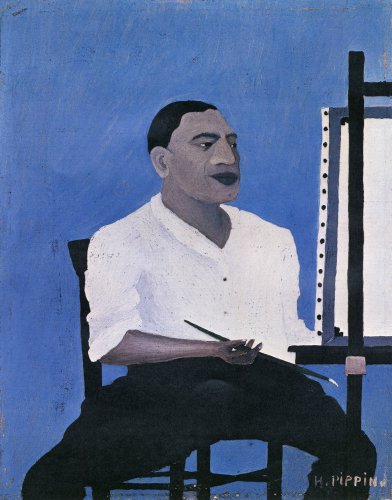
“Self-Portrait” by Horace Pippin, via Wikiart
The Harlem Renaissance was highly intertwined with the growing social consciousness of Black American communities. The goal of many artworks was to present a realistic depiction of Black Americans and challenge common stereotypical depictions of Blacks as inferior to Whites. A work from the Harlem Renaissance includes Langston Hughes’ The Negro Artist and the Racial Mountain. Published in 1925, it voiced a major philosophy of the literary movement by stating the desire to share a realistic, unbiased depiction of Black Americans as normal human beings. It also highlighted the importance of showing one's free and true self, without concern for the approval of the general population.
Although the Harlem Renaissance started to weaken after the impact of the stock market crash and subsequent Great Depression, it created many major effects. Economically, the Harlem Renaissance could only happen because of the flourishing of Black businesses and the general economy. Through the Great Migration, Black businesses could be established and Black people could take on better-paying industrial jobs, thus opening economic opportunity separate from the traditionally oppressive work of sharecropping. This encouraged communities to promote their businesses and art to their own people, and become self-sufficient. For example, the Harlem Renaissance saw the creation of multiple Black-owned magazines and journals such as Crisis, The Messenger and Opportunity. However, beyond featuring the work of Black artists, these titles also contained general articles discussing the Black population, such as their participation in the First World War.
Socially, the movement was diverse in the art styles expressed due to the people from different cultural spheres of the Black identity (African, Caribbean, and so on). The popularisation of jazz that became a hallmark of the movement in Harlem was originally brought from the Black art scenes in cities like New Orleans, Memphis and St. Louis. The artists of this time were demonstrating pieces of racial pride that empowered and connected Black Americans on a global platform. This would later have inevitable political influences on the Black Arts Movement paralleling the Civil Rights Movement. The Harlem Renaissance, otherwise known as the “New Negro Movement”, created population-wide levels of social consciousness on the lack of enforced civil rights for Black Americans. As a result, Harlem became the home for multiple Black civil rights and empowerment groups, including the National Urban League, the Brotherhood of Sleeping Car Porters, the black leadership of NAACP, and Marcus Garvey’s “Back to Africa” nationalist movement. The common racial struggle of Black Americans was openly talked about, and demands of civil rights became seeded in communities that would eventually organise in the 1960s in the forms of protests, sit-ins and speeches.
The Harlem Renaissance is an example of how an art movement connected as well as empowered a marginalised community. It is considered to have had a changing influence on many people today as well as on future movements.
Also check out: Paintings by Aaron Douglas | The Ways of White Folks by author Langston Hughes | A video about musician Duke Ellington
Cuban Revolution
Any government needs the support of its people, especially a newly established one. For Cuba, a country that underwent the strains of US economic embargoes and global isolation, public support for its national ideals was crucial. Art and culture were thus used as tools to engage its citizens.
The Cuban Revolution is said to have formally started after 26 July 1953, the date of Fidel Castro’s failed raid on a Santiago army barracks against the dictator Fulgencio Batista. Castro, himself a practising lawyer, chose to defend himself in his public hearing. He and his brother Raúl were sentenced to prison but released early on amnesty due to international pressure. Castro fled to Mexico after which to organise revolutionary masses and continued fighting Batista’s regime until 1 January 1959, when the rebels overthrew the government and forced Batista to flee the country. Fidel Castro then became president, a role in which he served from 1959 to 2008.
Immediately after establishing this new government, Castro employed the use of art to spread his revolutionary agenda. He set out to associate “everything with the revolution” and used multiple art forms to spread state propaganda. During this period, works of photography, film, poster art and paintings were created for this purpose. For instance, artist Raul Martínez, known for painting numerous portraits of revolutionary heroes, created the film poster for the film, Lucía . The movie, told through the perspectives of young Cuban women, depicts Cuba’s transition from times of dictatorship to its eventual revolution.
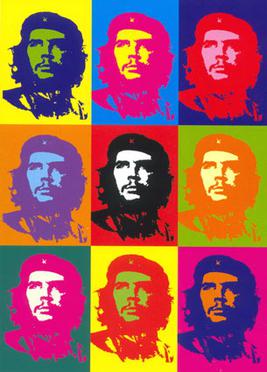
Gerard Malanga’s 1968 Andy Warhol forgery of Che Guevara. Fair use. Source: Wikipedia
In communist Cuba, billboards are not occupied by commercial advertisements, but by poster art illustrating revolutionary motifs and scenes. Created by the various government organisations for propaganda purposes, rather than by individuals or communities, they reflect the government-approved portrayal of Cuba to its people and the rest of the world. Over the years, Cuban art has gained international attention and given the country a platform to showcase its history, culture and government.
One of the most famous pieces to come out of the Cuban Revolution is the photo of the revolutionary figure Che Guevara by photographer Alberto Korda. Named Guerrillero Heroico , this image was popular among youth in the US and Europe during the counterculture movement of the 1960s–70s, and sparked active discussions of Cuban socialism. Since then, there have been different renderings of the famous portrait by artists from around the world. One of the most well-known adaptations is Andy Warhol’s 1968 “Che Guevara” painting—it was originally created by Warhol’s friend Gerard Malanga who mimicked the former’s signature pop art style without his permission; Warhol later “authenticated” the piece, giving his name and status to the work on condition that all proceeds went to him. Today, Che Guevara is recognised as an international icon of revolution, and his famous Warhol portrait is said to signify “anything to anyone and everything to everyone”. Castro’s regime’s effective use of art to spread his party’s ideals speaks volumes on the influence of art within political ideology.
Art can be used like a form of advertising, to fuse the political agenda of a state into the very culture of society. It is an effective messaging tool because it represents the ideals of a society through the eyes of the artist, and engages the public in both emotional and philosophical ways. Unlike traditional speeches and broadcasts by politicians, art can cause a visceral reaction and affect people on very personal levels.
Also check out: Paintings by Douglas Perez | Photography by Walker Evans | Cuban poster art
Chinese Environmental Art
Since the advent of social media and the Internet, there has been growing awareness in China about environmental issues, specifically air pollution. Chinese “eco-artists”, with their environmentally focused art, have also used their work to call attention to and create dialogue about these topics. On the one hand, the Chinese government is focused on the country’s growth and development. On the other hand, however, its rapid development is what’s contributing to environmental damage and negatively affecting citizens’ well-being.
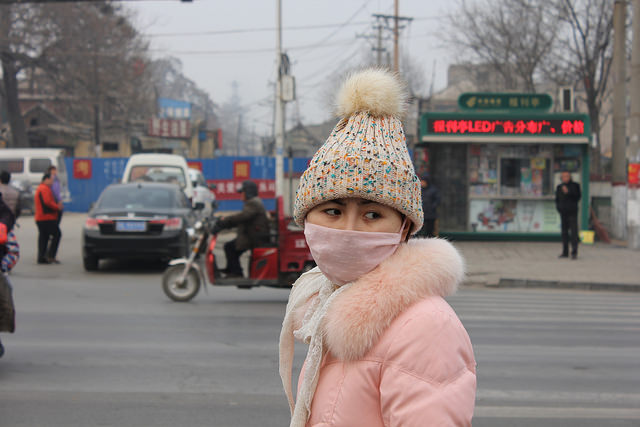
Chinese woman wearing pollution mask, image by V.T. Polywoda via Flickr
Today, the widespread use of social media and the Internet has given many Chinese people the opportunity to access information about the country’s severe pollution problem. In some cases, citizen outrage has led to protests and harsh criticisms of the government. In 2014, a “war on pollution” was declared, and the Chinese government could no longer ignore the issues of air pollution, water shortages, illness and premature deaths. Facing pressure both from its people as well as from abroad, the country’s leadership now has to address these environmental issues to validate its legitimacy both internally as well as on the international stage.
Presently, the Chinese government has increased spending on renewable energy and made pledges to decrease future emissions. However, despite these steps, it is still heavily focused on GDP and expanding the country’s economic influence, and has not cut off its investments in environmentally unsustainable projects. To keep the government and businesses in check, continued participation and action from civil society is necessary to ensure that both public and private organisations engage in environmentally sustainable practices.
Environmental art is one such way of rallying the support of the general public. In 2009, the China Environment Protection Foundation created an art initiative to remind people of the growing interference of urbanisation on nature. Featuring paintings done in the shan shui style by Shanghainese artist Yang Yongliang, the campaign’s message was that the landscape of their country is “Nice from afar, but far from nice.” From a distance, the art resembles mountains, hills and waterfalls shrouded in a mysterious mist. However, once the viewer steps closer and looks in greater detail, they can see that the art piece is composed of urban structures, construction sites, traffic and skyscrapers—all made to imitate the look of pure nature. This environmental art campaign won many awards for its effectiveness in conveying the mark of human encroachment on nature. There are also many performance artists and activists who employ innovative ways to raise awareness for environmental issues. For instance, Chinese fashion designer Kong Ning creates environmental-conservation-inspired gowns and presents her views in public displays of her statement garments. Other artists, such as Yuan Xikun and Cai Guoqiang, have also been creating sculptures and paintings with environmental messages; in Yuan’s own museum, the Jin Tai Art Museum, we can find sculptures of prominent figures in the quiet outdoors.
However, “eco-artists” are not all professionals. For instance, civilians themselves have been participating in China's “smog art movement”, where anybody can use art, photography, painting, installations, film or dance to creatively depict the most visible consequences of the air pollution problem. For example, in 2014, group gathered in front of the Temple of Heaven in Beijing to pray for blue skies, serving as a visual reminder on the importance for people to revere nature. Other instances include people putting pollution masks over the mouths of public statues, making controversial art on breathing masks, or wearing the masks in their wedding photos—all in the name of calling attention to China’s air pollution. Thanks to professional as well as civilian eco-artists, more Chinese citizens have become more aware about environmental issues, as well as the importance of having clean air, safe food and clean drinking water. Although the conversation can be expanded to cover other consequences of environmental damage, such as climate change and species extinction, public dialogue is presently limited to issues directly affecting the populace.
Hopefully, over time, more environmental art in this direction can help bridge the gaps in the conversation.
Also check out: Yang Yong’s shan shui environmental art | Video about fashion designer and performance artist Kong Ning | More examples of smog art
Singapore Demolition Art
Compared to other countries, there are not many examples of art movements in Singapore. In this business-driven city-state, art is mostly presented to the public in the neat confines of museums and galleries, and feature the works of famous artists. While they may exist, provocative art by newer artists, and which openly challenge prevailing values and social norms, are not easily found in open venues.
Here, most art spaces are state-owned, and privately owned art spaces tend to be expensive to rent and difficult for up-and-coming artists to access. Before they can be exhibited publicly, an artist’s works have to be screened by the Media Development Authority. As a result, for creators who do not wish to be censored, or to self-censor, their only other option is to self-exhibit within a private art space, though as earlier mentioned, the rental fees are high and there is fierce competition for a limited number of spots.
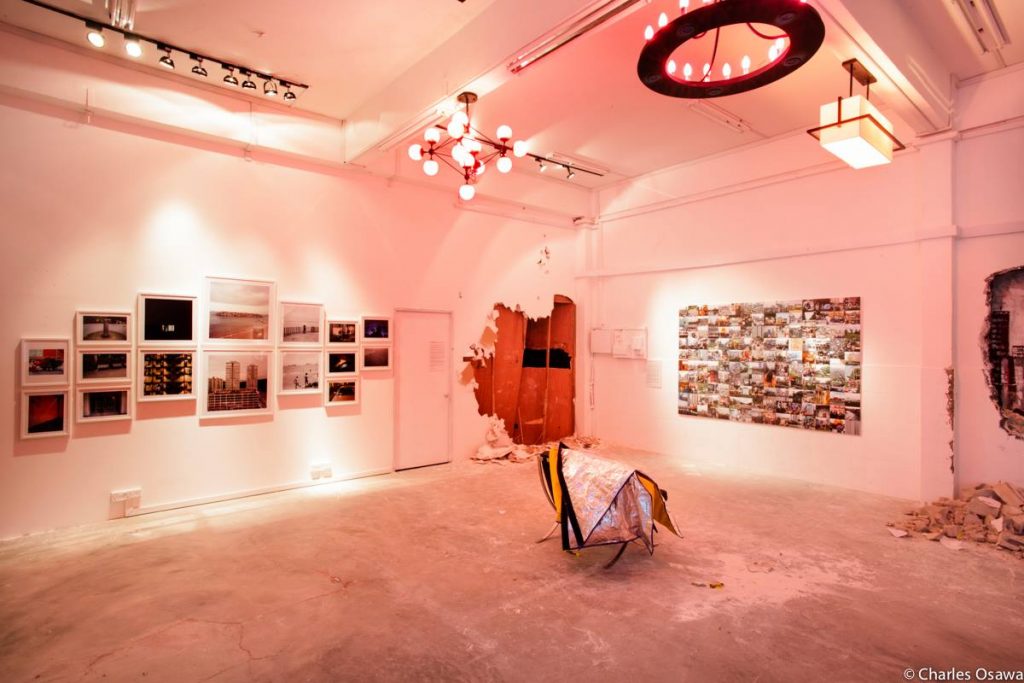 "Demolition Party" at the Mill. Photo courtesy of WeJungle and Charles Osawa
"Demolition Party" at the Mill. Photo courtesy of WeJungle and Charles Osawa
As such, many newer artists have turned to innovative methods to present their works, such as in buildings scheduled for demolition. Demolition art, also seen in cities like Tokyo and Seoul, is a type of “ephemeral art” which channels the freedom and temporal nature of street art. However, this movement has a special significance in the context of Singapore, a country that sees many of its buildings torn down and rebuilt in the name of urbanisation. Structures here are often described as having “short building life syndrome” because they are only used for a short period of time before they are torn down and replaced by newer, more modern buildings. Artists have therefore found in about-to-be-demolished buildings an affordable venue to showcase their works.
Demolition art consists of grassroots exhibitions that are artist- or proprietor-led. They normally occur when the proprietor wants to have their building memorialised before demolition, usually in the form of an event. At this event space, they invite Singapore-based artists to exhibit their works and hold performances. Many of these demolition exhibits touch on the themes of spontaneity and chaos, and encourage community engagement and collaboration. Before the upcoming demolitions of The Mill and Eminent Plaza, artists have used the spaces to create art depicting the tension resulting from Singapore’s rapid reconstruction. The works invited viewers to reflect on the past and the identities they lose when their homes and communal buildings are torn down—also to consider how demolition destroys not only the physical buildings but also their history and memories. The artwork on Eminent Plaza was a commentary on its questionable tenant mix—massage parlours and karaoke bars—while the works at The Mill explored the idea of “destruction and rebirth”.
Both these instances of demolition art demonstrates how the community can use art to process their feelings of displacement and loss following a building’s “death”.
Also check out: Singapore’s street art scene | WeJungle's Demolition Party pictures
Changing Your World
Throughout history and across the world, artists have used their creations in innovative ways to share ideas and call attention to various issues. And on a broader level, art movements allow us to see art's effectiveness in sending a strong message, sparking an emotional reaction, raising awareness and inviting dialogue. So the next time you enjoy art of any form, notice the impact it is having on you. It could very well be changing the way you look at the world—and hopefully in a positive way.
Banner image: “From Slavery Through Reconstruction” by Aaron Douglas. Fair use. Image via Wikiart
 |
Stephanie Tran Rojas was a 2018 Summer Associate (Editorial) at the Lien Centre for Social Innovation. Born and raised in San Diego, California, she is a third-year nursing student from the University of Pennsylvania. She sees media and art as invaluable tools for social change, and believes that “with art, one can create an intimate connection between strangers that spans across time and space”. Stephanie is additionally interested in the media as a platform for public health campaigns and the use of literature to bring about ideological shifts. In her free time, she enjoys incorporating art into her daily life with dancing and writing. She can be reached at trojas@upenn.edu |






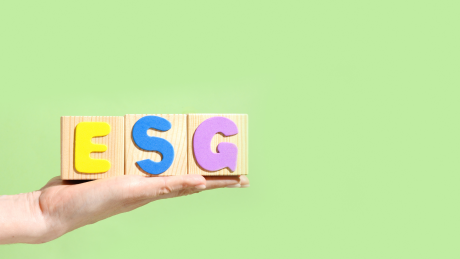

Comments